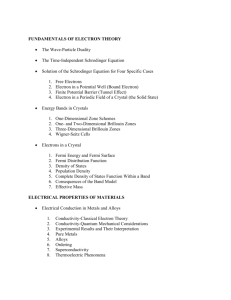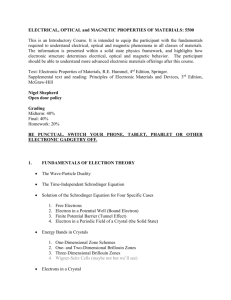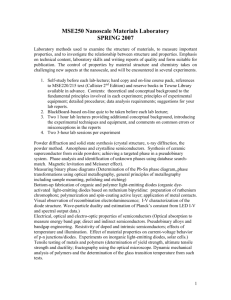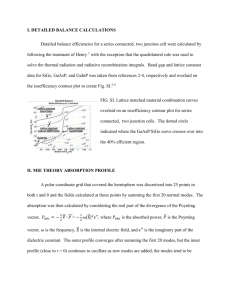Lecture 34
advertisement
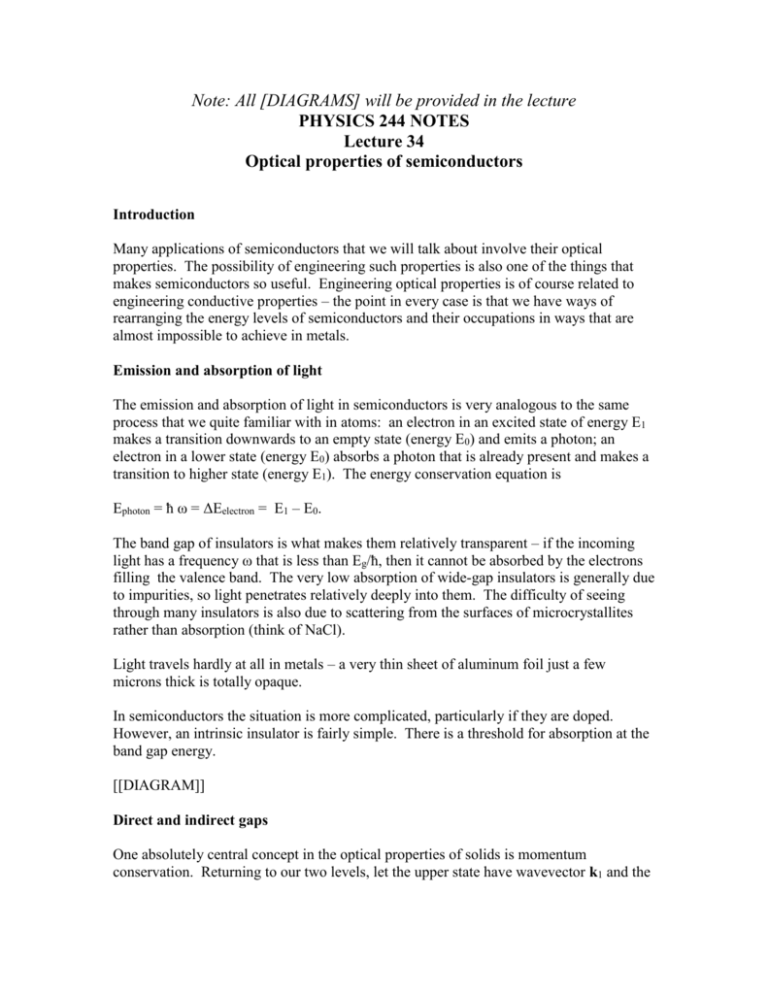
Note: All [DIAGRAMS] will be provided in the lecture PHYSICS 244 NOTES Lecture 34 Optical properties of semiconductors Introduction Many applications of semiconductors that we will talk about involve their optical properties. The possibility of engineering such properties is also one of the things that makes semiconductors so useful. Engineering optical properties is of course related to engineering conductive properties – the point in every case is that we have ways of rearranging the energy levels of semiconductors and their occupations in ways that are almost impossible to achieve in metals. Emission and absorption of light The emission and absorption of light in semiconductors is very analogous to the same process that we quite familiar with in atoms: an electron in an excited state of energy E1 makes a transition downwards to an empty state (energy E0) and emits a photon; an electron in a lower state (energy E0) absorbs a photon that is already present and makes a transition to higher state (energy E1). The energy conservation equation is Ephoton = ħ ω = ΔEelectron = E1 – E0. The band gap of insulators is what makes them relatively transparent – if the incoming light has a frequency ω that is less than Eg/ħ, then it cannot be absorbed by the electrons filling the valence band. The very low absorption of wide-gap insulators is generally due to impurities, so light penetrates relatively deeply into them. The difficulty of seeing through many insulators is also due to scattering from the surfaces of microcrystallites rather than absorption (think of NaCl). Light travels hardly at all in metals – a very thin sheet of aluminum foil just a few microns thick is totally opaque. In semiconductors the situation is more complicated, particularly if they are doped. However, an intrinsic insulator is fairly simple. There is a threshold for absorption at the band gap energy. [[DIAGRAM]] Direct and indirect gaps One absolutely central concept in the optical properties of solids is momentum conservation. Returning to our two levels, let the upper state have wavevector k1 and the lower state have wavevector k0. (I am using boldface for vectors.) So for emission, the momentum conservation equation is pphoton = p1 – p0 = ħ (k1 – k0). Now a typical energy involved in the transition would be 1 eV. So pphoton = | pphoton| = ΔE/c = 1.6 × 10-19 J / (3× 108m/s) = 0.53 × 10-27 kg-m/s, and kphoton = pphoton / ħ = 0.53 × 10-27 kg-m/s / 1.0 × 10-34 J-s = 0.53 × 107/m. On a band diagram, as we have seen, the units for k are π/a, where a is the lattice constant, so a typical magnitude for k or a difference in k’s, if we choose two at random, is Δ k = 1/ 10-10 m = 1010/m. This is much, much bigger than the k of the photon. The result is that momentum conservation constrains the transitions between extended states to be vertical – the kvector of the electrons is pretty much unchanged in an optical transition. [[DIAGRAM]] This has the consequence that direct-gap materials such as GaAs and most III-V’s can easily emit and absorb light at the band-gap frequency. The indirect-gap materials Si and Ge cannot. Indirect-gap materials are almost useless for optical devices: The excess carriers, whether holes or electrons, have no empty states to go to by optical means, whether absorption or emission. Luminescence Opto-electronic devices work by exciting electron-hole pairs; when a pair recombines it emits light. This is called luminescence. We may distinguish various kinds of luminescence by the excitation mechanism. Thermo-luminescence is the simplest – we simply heat up the sample until electron-hole pairs are created – light will then come out. This is usually not very practical, however – even narrow gaps are measured infractions of an electron volt, and one electron volt corresponds to about 104 K, which is enough to melt any solid material. Electro-luminescence is the excitation of carriers by electrical currents, often a practical method, and photo-luminescence is the excitation of carriers by light itself, also an important trick. Luminescence is further broken down into two categories according to the speed of recombination. Direct electron-hole recombination is usually relatively fast: the lifetime depends on the number of final states available, as we shall see, but times of 10-8 s are not unusual. This is called fluorescence. However, some applications require longer lifetimes. In this case, recombination occurs via intermediate states known as traps, usually localized states, often located on impurity sites. (Note that the issue of vertical versus non-vertical does not arise here, since a localized state does not have a definite kvector.) The excited electron first makes a transition to such a state, whose energy normally lies in the gap. Then it makes a second transition to finally recombine with the hole in the valence band. Often one of these transitions is non-radiative: by this is meant that the energy given off in the transition appears as heat, not light. This process is called phosphorescence, since it often occurs in materials that contain phosphorous. Lifetimes can be practically anything, up to and including hours and even longer. This is a very important process for applications such as TV screens, coating for light bulbs, etc. Recombination rates The recombination rate for electron hole pairs is given by dn(t)/dt |rec = -αr n(t) p(t), where n(t) is the number of electrons and p(t) is the number of holes. αr is a constant that we could calculate, given our knowledge of transitions between quantum states. It is an integral involving the electric field, and the initial and final state wavefunctions. We won’t try to compute it, but we may note that is a constant – it cannot depend on temperature or anything else. In addition to this there is a thermal generation rate for e-h pairs, dn(t)/dt |thermal = αr ni2, and the reason for writing it this way will be come clear in a moment. Now let us say that we are in thermal equilibrium in an intrinsic semiconductor. This is a steady state, and n(t) = p(t) so 0 = dn/dt|total = αr ni2-αr n(t) p(t) = αr ni2-αr n2(t). This n(t) = ni , a constant. Thus ni has the meaning of the number of carriers in an intrinsic semiconductor in thermal equilibrium. It is a strong function of temperature. In thermal equilibrium in general, we have 0 = dn/dt|total = αr ni2-αr n(t) p(t), so n(t) p(t) = ni2 – the product of electron and hole concentrations (in equilibrium!) is always the same – it does not depend on doping, which is somewhat surprising. Note that in an n-type material, we would have n(t) >> p(t), and vice-versa for a p-type. Now let us think about a situation where we shine a pulse of light on a p-type sample. n(0) will depend on the strength of the pulse, and then it will relax back to its equilibrium value nc = ni2/nv. We have n(t) << p(t), but p(t) is not much changed from its base value, so let p(t) = nv dn/dt|total = αr ni2-αr n(t) pv, so n(t) = nc + [n(0)-nc] exp(-t/τ), where τ = 1/nv αr . Similarly for n-type we have τ = 1/nc α r. Note that in both cases we are talking about the population of e-h pairs: these equations show that the response time of the device can be controlled by adjusting the doping level.
